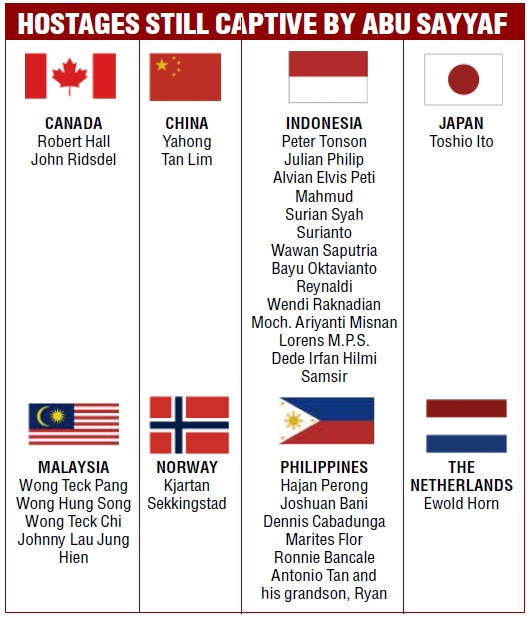
The military is pleading for civilian help in the fight against a rash of kidnappings in western Mindanao and the continued captivity of several victims taken as early as 2010, asking people to report the presence of captors or captives in their communities.
The Moro National Liberation Front (MNLF), which has a peace deal with the government, offered to help but would move only with government permission, according to a ranking MNLF leader.
Dr. Samsula J. Adju, chair of the MNLF’s Global Roving Diplomacy and Peace Advocacy, said the group was willing “to engage.”
Adju said the MNLF was willing to negotiate with the Abu Sayyaf, a terrorist organization, to end the hostage crisis “without bloodshed and no ransom.”
The MNLF, said Adju, wants to help in the safe release of Indonesian hostages. Indonesia played a key role in the peace agreement between the MNLF and the Philippine government in 1996.
Key signs
Maj. Filemon Tan Jr., spokesperson of the Western Mindanao Command, said it was not difficult to determine whether an individual or group of people is a kidnap victim.
“They speak foreign languages,” said Tan. He said some of the victims, like the 14 Indonesians and four Malaysians recently kidnapped by the terrorist group Abu Sayyaf, “may look like Filipinos.”
Tan said civilians should report to authorities unusual activities in their communities or the presence of “unfamiliar faces.”
Tan said aside from villagers, local government officials also have an important role in helping locate kidnappers and their victims.
Local officials, he said, should take the lead in turning their communities into “hostile places for these bandits.”
Tan issued an appeal as the military prepared for a major offensive against crime groups in Sulu province.
“We cannot provide details,” Tan said.
“But as we speak, troops are already preparing there and this is because of the kidnapping where the captives were reportedly brought to Sulu,” he added.
No ransom
Retno Marsudi, Indonesian foreign minister, said in a statement released to Indonesian media covering the kidnapping here that the Indonesian government adheres to the no ransom policy and has no role in negotiations with the Abu Sayyaf.
The 14 Indonesian captives had been identified as Peter Tonson, Julian Philip, Alvian Elvis Peti, Mahmud, Surian Syah, Surianto, Wawan Saputria, Bayu Oktavianto, Reynaldi, Wendi Raknadian, Moch. Ariyanti Misnan, Lorens M.P.S, Dede Irfan Hilmi and Samsir.
The four Malaysians, taken from Sarawak on April 1, are Wong Teck Pang, Wong Hung Song, Wong Teck Chi and Johnny Lau Jung Hien.
The other kidnap victims in the hands of the Abu Sayyaf are Japanese treasure hunter Toshio Ito, who was kidnapped in Pangutaran, Sulu, in July 2010; Dutch bird watcher Ewold Horn, who was taken captive in February 2012 in Panglima Sugala, Tawi-Tawi province; Chinese national Yahong Tan Lim, who was kidnapped in Isabela City in May 2014; Filipino fish traders Hajan Perong and Joshuan Bani, who were kidnapped in Bongao, Tawi-Tawi, on June 2, 2014; Filipino businessman Dennis Cabadunga, who was taken in Labason, Zamboanga del Norte province, in May 2015; Canadians Robert Hall and John Ridsdel, Norwegian Kjartan Sekkingstad and Filipino Marites Flor, who were kidnapped on Samal Island on Sept. 21, 2015.
Other victims are Ronnie Bancale, a Filipino fish trader kidnapped on Feb. 14 in Sulu and Antonio Tan and his grandson, Ryan, who were taken in Lapuyan, Zamboanga del Sur province, in March.
The Abu Sayyaf had given ultimatums in the case of some of the victims.
For the Samal captives, the bandit group said the ransom demand of P300 million should be paid on April 25 or the victims would be killed.
The government war on the Abu Sayyaf has led to the killings of several of its top leaders but other terrorist groups have emerged.
Recently, police said it arrested the head of a local terror group calling itself Rajah Solaiman Movement (RSM) in Zamboanga City.
Supt. Roger Sebastian, of the Criminal Investigation and Detection Group (CIDG), said Melquiades Pabico Abrera II had been arrested in Sta. Barbara village in the city.
“He is known as the architect and planner of RSM,” Sebastian said.
RSM is an organization founded by Islam convert Ahmed Santos in 1991. It reportedly gets its funding from the Jemaah Islamiyah and its members get training from the Abu Sayyaf.
It was believed to be behind the 2004 Superferry bombing that killed 116 people.
http://newsinfo.inquirer.net/780808/civilian-help-sought-to-end-kidnappings

No comments:
Post a Comment
Note: Only a member of this blog may post a comment.